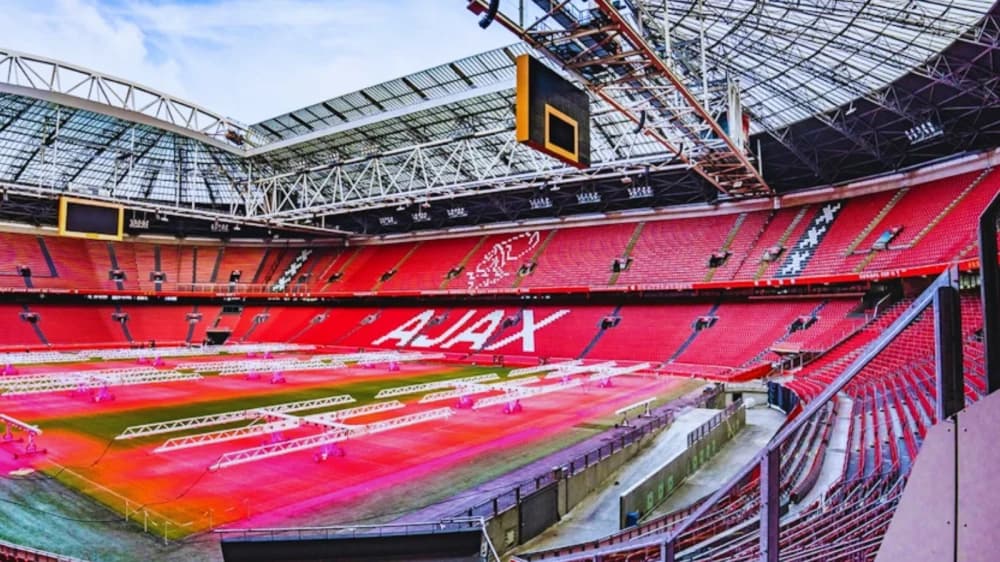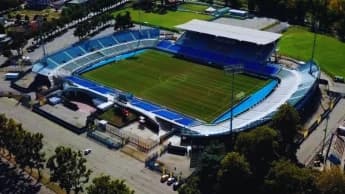
The Johan Cruyff Arena stands as a symbol of Dutch football and innovation, serving as the home of AFC Ajax and hosting major international events and concerts in a dynamic setting.
Indroduction
Situated in the southeastern region of Amsterdam, the Johan Cruyff Arena is the largest stadium in the Netherlands and a key part of Dutch football culture. It is the home ground for AFC Ajax, a leading club in Dutch football history, and also hosts matches for the Netherlands national football team. The stadium opened in 1996 and was originally called the Amsterdam Arena, but it was renamed in 2018 to honour Johan Cruyff, an iconic figure in global football and a national hero of the Netherlands.
With a seating capacity of 55,865, the stadium serves as a leading venue not only for football games but also for concerts and various large-scale events. It is equipped with a retractable roof and features an innovative pitch that can be moved and maintained in optimal conditions thanks to its tray design. This advanced technology enhances the stadium's status as one of the most modern football venues in Europe.
The Johan Cruyff Arena has been the venue for many significant football events throughout the years. It served as one of the primary locations for UEFA Euro 2000, a tournament co-hosted by the Netherlands and Belgium. More recently, the stadium was designated as a host venue for UEFA Euro 2020, which was postponed to 2021 due to the COVID-19 pandemic. It hosted four matches during the tournament, comprising three group stage games and one Round of 16 match. These events have further established the stadium as a prominent site for international competitions.
A significant historical event for the stadium occurred in 1998 when it hosted the UEFA Champions League Final between Real Madrid and Juventus. Real Madrid secured their seventh European title with a narrow 1–0 victory in the match. Furthermore, in 2013, the Johan Cruyff Arena served as the location for the UEFA Europa League Final, where Chelsea triumphed over Benfica.
In addition to being a leading football venue, the stadium is a vital part of Amsterdam’s cultural and entertainment landscape. It frequently hosts concerts featuring international artists and is equipped to facilitate quick transitions between sports and entertainment events. With a retractable roof and adaptable seating configurations, it offers great versatility, making it suitable for a wide range of events.
The Johan Cruyff Arena, home to AFC Ajax, is a significant part of Dutch football culture. Ajax, renowned for their historic successes in Europe and dedication to developing young talent, energize the stadium during their domestic league games and European matches. The supporters, famous for their fervent enthusiasm, transform the arena into a vibrant hub of noise and excitement on game days.
The renaming of the stadium to Johan Cruyff Arena in 2018 served as a tribute to the football icon who left a lasting impact on both Dutch and international football. Cruyff’s contributions to the game, in both playing and coaching capacities, are immeasurable, and choosing to honor him with the stadium’s name has infused the venue with significant emotional meaning.
Regarding its infrastructure, the Johan Cruyff Arena offers excellent accessibility. It is well-linked by public transportation options, such as trains, metro, and buses, facilitating easy access for both local and international attendees at events. Additionally, the stadium has embraced sustainable design principles and is making progress toward becoming an energy-neutral venue, utilizing solar panels and energy-efficient systems.
The Johan Cruyff Arena represents more than just a venue for football. It stands as a symbol of Dutch sports excellence, showcases architectural innovation, and serves as a tribute to one of the sport’s greatest legends.
Historical Background and Building Process
The Johan Cruyff Arena, previously known as the Amsterdam Arena, is a contemporary football stadium situated in the Bijlmermeer district of Amsterdam-Zuidoost. The concept of building a new stadium in Amsterdam emerged from a pressing need. By the late 1980s, Ajax Amsterdam had surpassed the capacity and facilities of its former venue, De Meer Stadion, which could no longer adequately serve the club's requirements in terms of safety, capacity, and amenities. Additionally, the Olympic Stadium, which had also hosted Ajax games, was deemed outdated.
In 1993, the proposal for a new stadium began to gain significant traction. The Amsterdam city council sanctioned the project, and the foundation stone was laid in November 1993. This initiative was a joint effort between the city of Amsterdam, the football club Ajax, and various commercial partners. The stadium's construction was officially completed in 1996, and it was opened on August 14, 1996, with a friendly match featuring Ajax and AC Milan.
Designed by architect Rob Schuurman, the stadium was among the pioneering football venues in Europe equipped with a retractable roof. This roof, made of two translucent panels, can be opened or closed in about 18 minutes. This feature enables the stadium to accommodate a diverse range of events, regardless of weather, enhancing its multifunctional capabilities.
A distinctive feature of the stadium's construction was its sliding pitch. The grass is laid on a removable tray system, enabling easier maintenance and replacement without disrupting the stadium's schedule of events. This innovative technology was quite advanced for its time and helped to maintain the quality of the pitch for football matches.
The estimated total cost for constructing the stadium was €140 million. Initially, the stadium had a seating capacity of about 54,000, which was later increased to roughly 55,865 following renovations and expansions. The design and construction adhered to modern safety standards, included accessibility features, and implemented crowd control systems, setting a benchmark for future stadium projects across Europe.
The stadium's placement in Amsterdam-Zuidoost, a district experiencing substantial urban renewal, was also a strategic decision. It contributed to the enhancement of local development and infrastructure, including public transportation networks. The Arena Boulevard, a key thoroughfare in the area, transformed into a lively center for fans and visitors, featuring shops, restaurants, and entertainment venues that enriched the overall stadium experience.
During its initial years, the stadium faced some criticism regarding the quality of the pitch and the acoustic experience. Over time, these issues were progressively resolved through various technical enhancements and upgrades. The stadium also underwent multiple renovations to modernize its facilities and meet UEFA standards for hosting international events.
On April 25, 2018, it was officially announced that the stadium would be renamed Johan Cruyff Arena to honor the legendary Dutch football player and coach Johan Cruyff. The renaming occurred after receiving approval from the Cruyff family and other relevant parties, with the change taking effect that same year. This decision received widespread support in the Netherlands, acknowledging Cruyff’s significant contributions to both Dutch and global football.
Since its opening, the Johan Cruyff Arena has hosted a variety of significant football events, including the UEFA Champions League Final in 1998, as well as matches during UEFA Euro 2000 and UEFA Euro 2020. The stadium has also served as a venue for concerts by internationally acclaimed artists, solidifying its status as a prominent landmark in Amsterdam's cultural and sporting scene.
The Johan Cruyff Arena serves as the home ground for Ajax and a key venue for Dutch football, embodying innovation and honoring a national hero. Its design and history represent a fusion of ambition, technological progress, and cultural importance.
Architectural and Design Features
The Johan Cruyff Arena is renowned for its contemporary architectural design and cutting-edge features, which establish it as one of the most sophisticated football stadiums in Europe. Created by Dutch architect Rob Schuurman, the stadium embodies a harmonious combination of functionality, sustainability, and visual appeal. Its development was part of a larger effort to rejuvenate the Amsterdam-Zuidoost area and establish a versatile sports and entertainment venue capable of hosting both football and various other events.
A standout architectural aspect of the Johan Cruyff Arena is its retractable roof. At the time of the stadium's construction, this feature was groundbreaking, making it the first stadium in Europe to incorporate such a design. The roof is made up of two translucent panels that can be opened or closed in about 18 minutes. This advancement allows events to take place regardless of the weather, greatly increasing the stadium's adaptability. The roof is held up by a large steel truss system that spans the width of the stadium, adding to its strong and modern aesthetic.
The design of the stadium's exterior features an oval shape, complemented by glass and steel materials that provide a modern and elegant appearance. The largely transparent outer façade allows ample natural light to flood in, fostering an atmosphere of openness. This architectural choice not only boosts aesthetic appeal but also enhances energy efficiency by minimizing the reliance on artificial lighting during the day.
One significant design feature is the sliding pitch system. The grass playing field is placed on a tray that can be moved in and out of the stadium. This flexibility allows for optimal maintenance of the pitch in natural conditions and helps prevent damage during non-football events like concerts. The system guarantees that the grass stays in excellent condition for Ajax games and international matches.
The seating layout in the Johan Cruyff Arena is specifically designed to ensure outstanding views from all angles. The tiers are sharply inclined to bring fans closer to the field, which enhances the overall viewing experience and creates an electrifying atmosphere during games. The stadium seats 55,865 fans, and the seating is color-coded in Ajax's signature red and white, further emphasizing the club’s identity throughout the arena.
The stadium's internal layout features a variety of contemporary amenities, including hospitality suites, VIP lounges, media centers, dressing rooms, and versatile conference areas. Its design facilitates efficient crowd movement with spacious concourses, numerous entry and exit routes, and clear signage. A primary focus has been on accessibility, ensuring that provisions for disabled attendees are in place along with integrated facilities that comply with international standards.
The Johan Cruyff Arena is recognized for its dedication to sustainability. It is equipped with over 4,200 solar panels on its roof and has a nearby wind turbine that generates renewable energy. Furthermore, the stadium utilizes an energy storage system that consists of recycled batteries from electric vehicles. It also collects and reuses rainwater for irrigation of the pitch, and various energy-saving systems are implemented to minimize environmental impact.
The acoustics of the stadium have been progressively improved to resolve earlier issues. Changes made to the roof and internal structures have significantly enhanced sound distribution, making the venue ideal for concerts and large events. Additionally, the retractable roof contributes to amplifying crowd noise during football games, further enhancing the stadium’s reputation for an energetic and thrilling matchday experience.
The Johan Cruyff Arena is conveniently situated within Amsterdam's public transport network. It can be easily reached by train, metro, and bus, making it accessible for both local and international guests. The surrounding infrastructure, including the Arena Boulevard and nearby entertainment venues, enhances the stadium's multifunctional purpose.
The design and architectural elements of the Johan Cruyff Arena exemplify a progressive mindset that merges innovation, sustainability, and an enhanced user experience. It serves as a benchmark for contemporary stadium architecture and a testament to Dutch architectural creativity.
Ambiance and Audience Experience
The Johan Cruyff Arena provides one of the most engaging and exhilarating fan experiences in European football. As the home stadium of AFC Ajax, it consistently attracts enthusiastic supporters who generate a lively and spirited atmosphere that enhances every matchday. Each aspect of the stadium, from the seating layout to the acoustics of the roof, plays a role in creating a memorable experience for fans, whether they are present for a domestic Eredivisie match or an international conflict.
A key element of the atmosphere at the Johan Cruyff Arena is the passion and dedication of Ajax supporters. Renowned for their vocal presence and strong traditions, Ajax fans infuse the stadium with an energy and spirit that is both uplifting and motivating. The south stand, referred to as the 'F-Side,' serves as the pulsating core of the crowd, where ultras orchestrate chants, wave flags, and showcase elaborate tifos. This area is emblematic of fervor and enthusiasm, playing an essential role in creating a dynamic atmosphere that inspires the players and unsettles the opposing teams.
Matchday at the Johan Cruyff Arena starts long before the actual match begins, as fans congregate around the Arena Boulevard. This lively area is filled with food stalls, merchandise shops, and entertainment venues. The atmosphere created during this pre-match gathering enhances the sense of community that characterizes Ajax’s home games. The existence of fan areas and live entertainment surrounding the stadium ensures that the matchday experience extends beyond just the ninety minutes on the field, transforming it into a full-day celebration.
Upon entering the stadium, fans are greeted by a sweeping view of the pitch from steeply designed tiers that bring them closer to the action. The stadium's acoustics are crafted to capture and enhance sound, turning even ordinary moments in the game into dramatic experiences. When Ajax scores, the crowd's cheer echoes throughout the building, generating a wave of emotion that elevates the excitement of live football.
The lighting and sound systems significantly enhance the experience for fans inside the stadium. Contemporary LED lighting and large video screens maintain fan engagement by displaying replays, statistics, and other matchday content. During evening games, the combination of lit stands and the chants of the crowd creates a spectacle that is both visually stunning and sonically impressive.
The stadium's facilities also contribute significantly to fan engagement. There is a wide variety of food and beverage options available throughout the concourses, catering to diverse tastes. Queue management is generally effective, and clear signage throughout the venue helps fans navigate easily to their seats or various amenities. Additionally, the stadium provides premium experiences through VIP boxes and hospitality lounges, enabling fans to enjoy the game in a more upscale environment.
The design of the Johan Cruyff Arena places a strong emphasis on accessibility. It features facilities for disabled fans, including wheelchair-accessible seating, elevators, and specialized assistance services. Additionally, the stadium's close connection to Amsterdam's public transport network facilitates easy arrival and departure for fans, with nearby train, metro, and bus stations. There are also parking facilities and bicycle storage available, promoting sustainable travel options.
During international matches and tournaments like UEFA Euro 2000 and UEFA Euro 2020, the stadium became a vibrant mix of cultures, with supporters from all over Europe creating a festive atmosphere. These occasions showcased the Johan Cruyff Arena's ability to accommodate a wide range of spectators while ensuring excellent organization and fan enjoyment.
At the Johan Cruyff Arena, security and crowd management are conducted efficiently and discreetly. Stewards and security staff are strategically positioned to assist fans, manage lines, and ensure safety without being intrusive. The stadium's design allows for swift evacuation in emergencies, and regular drills and updates prepare the staff for various scenarios.
Besides hosting traditional football games, the Johan Cruyff Arena also serves as a venue for concerts and cultural events, drawing in a diverse range of fans from various backgrounds. These events take advantage of the stadium’s outstanding acoustics, substantial capacity, and flexible infrastructure. Nevertheless, the matchday experience remains unparalleled, characterized by the fervor of Ajax supporters and the vibrant atmosphere that comes with high-stakes football.
The homage to Johan Cruyff brings a profound emotional connection to the fan experience. Throughout the stadium, patrons can discover murals, plaques, and displays honoring the Dutch football legend, serving as a reminder of the legacy that inspired the arena’s name. For many supporters, being present at a game in the Johan Cruyff Arena transcends merely watching football; it is about engaging with a rich football heritage that has endured across generations.
The ambiance and fan experience at the Johan Cruyff Arena blend passionate support, contemporary facilities, and efficient organization. Whether you are a lifelong Ajax fan or attending for the first time, the stadium offers an unforgettable experience that embodies the essence of Dutch football and the legacy of one of its most revered legends.
Documentation and Heritage
The Johan Cruyff Arena, previously known as the Amsterdam Arena, has established itself as one of Europe's top football venues, boasting a rich history and numerous remarkable records. Since its opening on August 14, 1996, the stadium has played a vital role in the successes of AFC Ajax, prestigious international competitions, and major entertainment events. The Arena has transcended its function as a mere sports facility; it represents modern Dutch football and pays homage to one of the greatest players in the history of the Netherlands.
A significant aspect of the Johan Cruyff Arena’s legacy is its enduring connection with AFC Ajax, the Netherlands' most successful football club. Following its move from De Meer Stadion, Ajax has established the Arena as its home venue, celebrating numerous Eredivisie titles, domestic cup wins, and unforgettable European matches within its confines. The stadium's state-of-the-art infrastructure and seating capacity have been instrumental in bolstering Ajax's aspirations both locally and on the continental level.
The Johan Cruyff Arena was the venue for the 1998 UEFA Champions League Final featuring Real Madrid and Juventus. This match is considered one of the most esteemed football encounters held at this location. Real Madrid triumphed with a score of 1–0, thanks to a goal by Predrag Mijatović, which earned them their seventh European title. Hosting this final further enhanced the stadium’s reputation as a premier venue capable of hosting high-profile events in accordance with UEFA's elite standards.
Besides hosting club competitions, the stadium has been an essential venue for the Netherlands national football team. It has held numerous matches for FIFA World Cup and UEFA European Championship qualifications. Additionally, the Johan Cruyff Arena was chosen as one of the venues for UEFA Euro 2000, which was jointly hosted by the Netherlands and Belgium. Throughout the tournament, the Arena accommodated several significant matches, including games from the group stage and a semi-final, demonstrating its capability to manage extensive international events with excellent organisation and full attendance.
The stadium's legacy was further enhanced by hosting matches during UEFA Euro 2020. Although the tournament was delayed by a year due to the global pandemic, the Arena successfully welcomed fans back under controlled conditions, solidifying its status as one of Europe's premier football venues. Amsterdam was chosen as one of the host cities, and the Johan Cruyff Arena showcased both exceptional logistics and enthusiastic crowd support, contributing to the excitement of the competition.
In addition to football, the Arena has gained acclaim for hosting acclaimed music concerts and entertainment events. Some of the most prominent global artists and bands, such as Michael Jackson, Beyoncé, U2, Madonna, and The Rolling Stones, have graced the venue with their performances. These events attract large crowds and play a significant role in enriching the stadium's cultural impact. With its retractable roof and superb acoustics, the venue is perfectly suited for concerts, allowing it to effortlessly transition from a sports arena to a music hall.
The Johan Cruyff Arena boasts several impressive records. It has hosted some of Ajax’s largest home crowds for both league and European matches. The stadium's peak attendance for a football game exceeds 54,000 during elite Eredivisie games and UEFA Champions League matches. The Arena's regular sell-out crowds highlight the dedication and enthusiasm of Ajax fans, solidifying its reputation as a stronghold for the home team.
A significant aspect of the stadium's legacy is its renaming in tribute to Johan Cruyff. On 25 April 2018, it was formally announced that the Amsterdam Arena would be renamed the Johan Cruyff Arena. This change honored the football icon who made a lasting impact on the sport, both as a player and as a visionary leader. Cruyff's influence on Ajax, Dutch football, and global football culture made him an appropriate figure for the venue. His philosophy of attacking and intelligent football is deeply woven into the identity of Ajax and the stadium that now honors his name.
The Johan Cruyff Arena has taken the lead in sustainability and innovation. It is recognized as one of the first stadiums worldwide to implement a large-scale energy storage system utilizing recycled electric vehicle batteries. Featuring over 4,200 solar panels and the incorporation of wind energy, the Arena sets a standard in advocating for eco-friendly stadium operations. This commitment to sustainability contributes to its lasting legacy and serves as a blueprint for future stadium designs.
From a technological standpoint, the Arena has undergone constant evolution. Improvements in field maintenance, fan engagement, digital ticketing, and security systems have positioned the stadium at the cutting edge of innovation. These developments have not only improved the matchday experience for supporters but have also reinforced the Arena’s reputation as a progressive venue.
The Johan Cruyff Arena is closely linked to the legacy of Ajax, the national team of the Netherlands, and the world of entertainment. It has hosted memorable football matches, iconic concerts, and significant innovations. Named after a football legend, the stadium continues to motivate future generations while upholding its reputation as a symbol of excellence in sports and culture.





